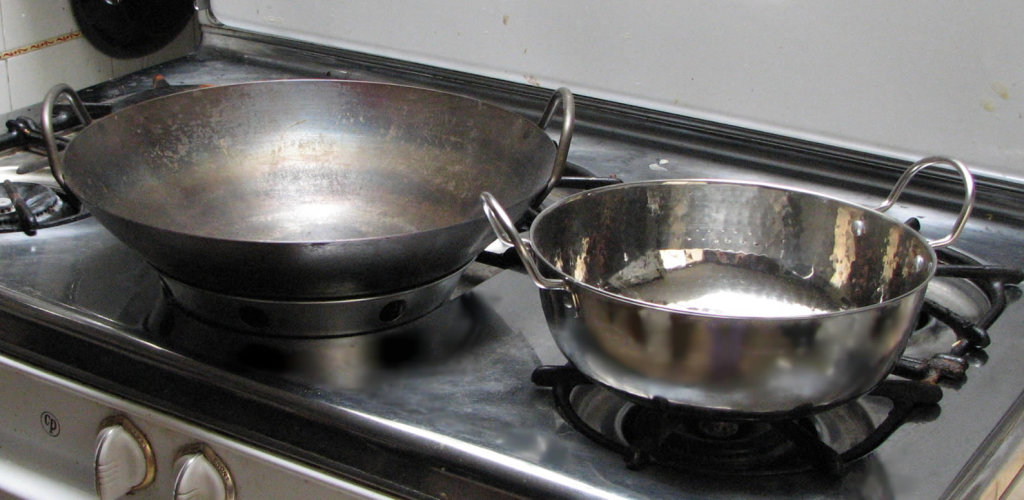Things I learnt about using a wok on a glass stovetop

So… as part of my “Aliette goes learning new ways of cooking”, and after the baking experiments, I’m now into using a carbon steel wok (mostly, I confess, because our non-stick one died about a month ago and I was really sick of replacing it every few years). I read Grace Young’s Breath of a Wok and Stir-Frying to the Sky’s Edge cover to cover, bought a wok from our local Chinatown, and then proceeded to do my own experiments [1].
There’s surprisingly little that I could find about using a wok on a glass stovetop, and I thought that I would accordingly post about it, if only to share. A lot of the stuff in Grace Young’s books and online focuses on electric stoves (which means coils, I assume), and warn you that an electric stove isn’t powerful enough to do stir-frying and you need to crank up the heat to maximum.
On my stove at least, this results in disaster. Because woks (and the de Buyer steel pans that I have) don’t like being heated fast, and also don’t much like having the radiant element of the stove right under them. And as a result, they warp, which is a big pain in the neck (and not something you can remedy once it’s happened, at least not without a lot of work that I’m in no way ready for), and they “dance” on the stovetop, i.e. don’t lie perfectly flat. The Wok Shop in San Francisco has an FAQ which describes the problem, which makes me think I’m not the only one to have it.
A carbon steel wok would probably warp as well on an electric coil or gas stove (though I suspect the flames of gas are a less violent contact than the full heat of the radiant element), but the thing is you probably wouldn’t notice it. Glass stovetops, unfortunately, are really unforgiving in that regard: the bottom of pans has to be absolutely flat, whereas it’s not really a problem if your wok is slightly warped and you’re cooking with gas or coils.
It might be linked to the wok gauge, but I’ve got a thicker de Buyer steel pan which has the exact same problem, so I suspect a wok would have to be very thick (and very heavy, and kind of defeating the point of reacting fast to the heat), in order not to warp. Also, I’ve killed one wok not knowing this (the one I have is my second one), so for what it’s worth…
(you might have a less, er, eagerly destructive glass stovetop which doesn’t heat up fast. In which case you can safely ignore most of this advice)
So, accordingly, my new cooking rules with a carbon steel wok on a glass stovetop:
- Find the right burner: on my stove the largest burner (which is actually larger than the wok base) is the friendliest and the least likely to warp the wok.
- Heat it up gradually (every stove is different. Mine must heat up fast, because I need to do 5 minutes on low heat, 5 minutes on low-medium heat and 5 minutes on medium heat before the wok is at the right temperature)
- If you have one of those powerboost things on the stovetop that make the stove heat up faster, for the love of God do NOT use it, it’ll kill the pan in the long run.
- Watch for temperature (on my stove I go to 7-7.5/9, seldom to the maximum). You’ll notice that the de Buyer FAQ for their steel pans says never go above moderate heat. Trust me, even moderate heat on an efficient stove is good enough for stir-frying.
- After you’re done, let the wok cool on the stove. Never EVER take it straight into the sink to pour some water into it.
(in the interest of full disclosure: my wok is the Ken Hom 31-cm carbon steel. My stove is made by Bosch but I have no idea which model it is, as it came with the house. Also, all of this applies to thin carbon steel pans like the de Buyer ones).
[1] If you want a quick book review: they’re great books because they focus on one technique and have inserts on how to do things, rather than being a compilation of recipes (I like compilations of recipes, but sometimes you need to pause and learn a bit about technique). The Breath of a Wok has a slightly better and slightly more expanded wok selection and wok care section (at least I found it more useful), and Stir-Frying to the Sky’s Edge is better on preparing ingredients for a stir-fry (cutting them, blanching them, etc.). Sky’s Edge is also more focused on the Chinese diaspora (mostly in North America and the Caribbean) and on how they adapted their dishes.
[ETA: edited some grumbly things which didn’t bring a lot to the review]
I’ve got some light peeves, but nothing serious: I thought both books were superb and well worth a read and/or add to your cooking library if you intend to go wokking.